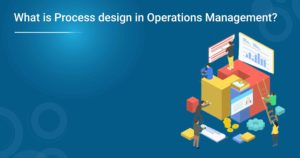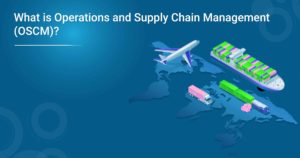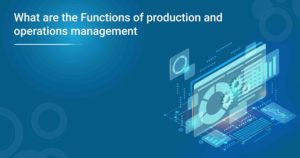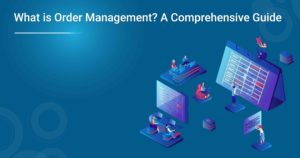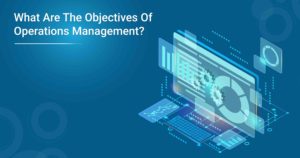The transformation process in operations management is all about converting inputs into outputs. This can be done either through manufacturing or service processes. The goal of the transformation process is to add value to the information so that it is worth more than the sum of its parts. To add value, the input must be transformed into something more beneficial to the customer.
The transformation process can be considered a value-added chain, where each link in the chain adds value to the final product. The most important part of the transformation process is choosing the right inputs. The wrong input can lead to a less-than-satisfactory output. Likewise, selecting the wrong manufacturing or service process can lead to sub-optimal results. Understanding the transformation process to optimise your operations and create a competitive advantage is essential.
Transformation Process in Operations Management: An Overview
The transformation process in operations management entails a series of activities that Convert inputs into outputs. The transformation process may be physical or chemical. In business, the term usually refers to manufacturing processes.
The inputs for the transformation process in operations management are typically raw materials, while the outputs are finished products. The transformation process aims to add value to the information and create products that meet customer requirements.
There are several steps involved in the transformation process in operations management:
- Inputs are received from suppliers.
- Materials are stored until they are needed.
- Production planning determines the order in which materials will be processed.
- Materials are moved to production areas.
- Workers convert materials into finished products.
- Products are inspected and tested to ensure quality.
- Finished products are shipped to customers.
What Are The Types of Transformation Processes in Operations Management?
Material Processing
There are various transformation processes in operations management, but material processing is one of the most common. This transformation involves taking raw materials and converting them into a finished product. The finished product can be either a physical good or a service.
There are many steps involved in material processing, but the basic idea is to take raw materials and turn them into something more useful. This usually involves adding value to the raw materials through some manufacturing process. For example, raw wood can be turned into furniture, or raw iron can be turned into steel.
Material processing is a critical part of operations management, as it is often responsible for creating the final products that customers will purchase. Because of this, it is essential to carefully plan and execute material processing activities to ensure that the final products meet customer expectations.
Information Processing
Operations management is about planning, directing, and controlling the activities that transform inputs into finished goods or services.
There are three main types of transformation processes: information processing, physical transformation, and chemical transformation.
Physical transformation converts raw materials into finished products through manufacturing, assembly, and packaging. Chemical transformation alters the chemical composition of substances to create new products or enhance existing ones. Information processing involves using data and information to perform decision-making, monitoring, and control tasks.
Customer Processing
Operations managers use transformation processes to convert inputs into outputs. The type of transformation process used depends on the nature of the operation.
The type of transformation process used would be production. For example, in a manufacturing firm, the input might be raw materials, and the output might be a finished product. In a service firm, the input might be a customer request, and the output might be the satisfied customer. The type of transformation process used would be customer processing.
There are four major transformation processes: production, fabrication, assembly, and customs processing. Production is the process of creating something from nothing using raw materials. Fabrication is the process of creating something from parts using tools and machines.
Assembly is about putting parts together to create a whole product. Customer processing is taking input from a customer and turning it into an output that meets their needs or expectations.
The type of transformation process used will depend on the nature of the operation. For example, production and customer processing may take place in a manufacturing firm that also provides services. In some cases, more than one transformation process may be used.
Types of Transformational Change
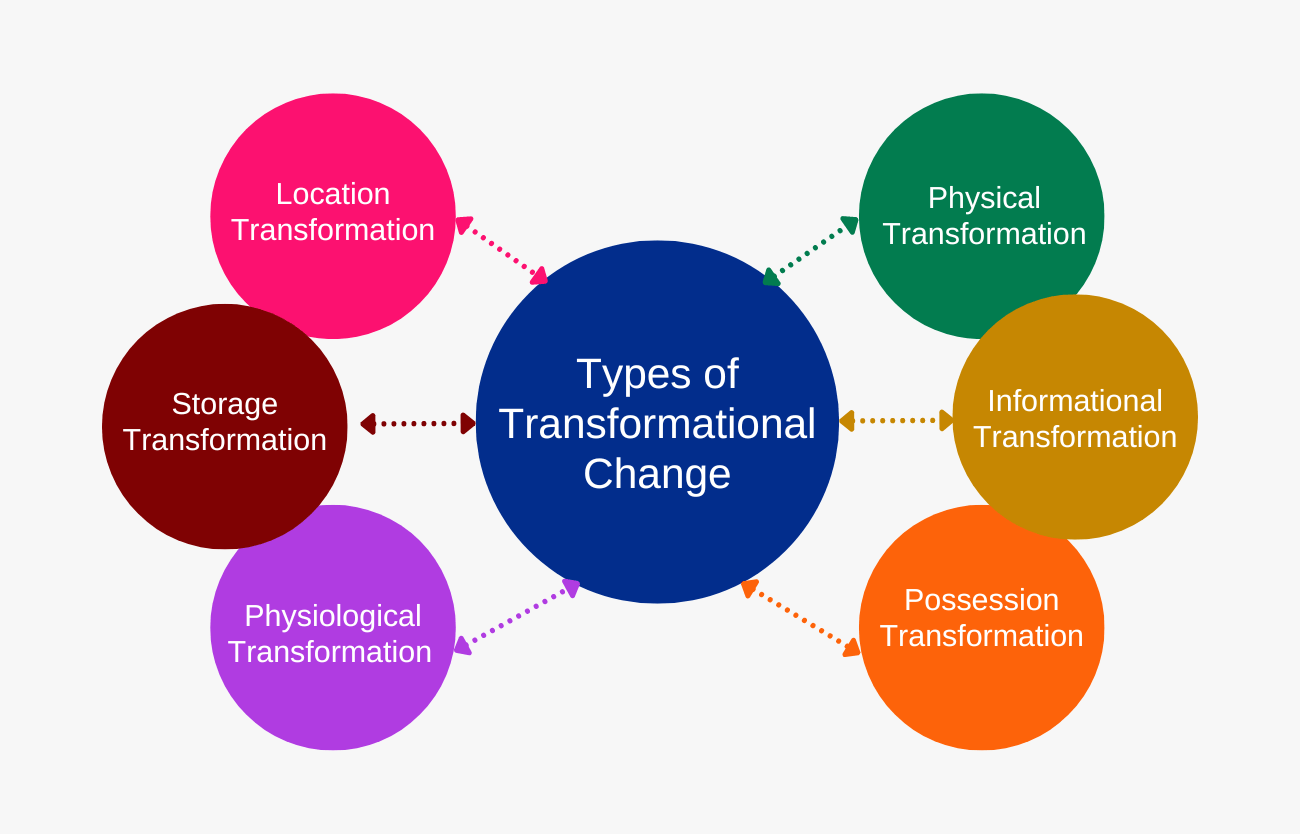
Physical Transformation
There are three types of physical transformation:
- Structural transformation – This type of transformation changes the organisation’s physical structure, such as the introduction of new product lines or the construction of new facilities.
- Process transformation – This type of transformation changes the way work is done within the organisation, such as introducing new production methods or adopting new technology.
- Behavioural transformation – This type of transformation changes the culture and behaviours of employees, such as introducing new values or changing how rewards are given.
Informational Transformation
An informational transformation is a process that changes the form or structure of information without changing its meaning. The most common type of informational transformation is data conversion, which involves converting data from one format to another. For example, you might convert a text file from a word processor into a PDF to read on any device.
Informational transformation is a type of change in operation management that helps an organisation understand its internal process and operations better to make necessary changes. It usually involves creating new or innovative ways to collect, store, share, and use information. The goal is to improve efficiency and effectiveness while reducing costs.
Various types of informational transformations can be implemented, depending on the organisation’s specific needs. Some common examples include data warehousing, business intelligence, and knowledge management.
Data warehousing refers to the process of storing data in a centralised location to enable easy access and analysis. This type of informational transformation can be used to track trends over time, identify areas for improvement, and make decisions based on real-time data.
Business intelligence involves using analytical tools and techniques to transform data into insights that can help organisations make better decisions. This type of informational transformation can be used to understand customer behaviour, optimise marketing campaigns, and predict future trends.
Knowledge management is organising and storing information to make it easily accessible and useful for those who need it. This informational transformation can help organisations share best practices, improve communication and collaboration, and promote innovation.
Also Read: What is Operations and Supply Chain Management (OSCM)?
Possession Transformation
Possession transformation is taking ownership of something, usually through purchase or investment. Such transformation is often used in business, allowing organisations to expand their reach and control by acquiring other companies or assets.
This can happen through several different means, such as a merger, acquisition, or divestiture. When this type of change occurs, it can significantly impact the operation management of the organisation.
Many factors need to be considered when an organisation undergoes a possession transformation:
- The new ownership structure will likely have different goals and objectives than the previous one. It can impact how decisions are made about operations and how resources are allocated.
- The new owners may want to change how things are done to improve efficiency or profitability.
- There may be changes in the regulatory environment that the organisation must adapt to.
Additionally, they need to communicate with all stakeholders about what is happening and get their buy-in for any proposed changes. An organisation can hope to realise its full potential by carefully planning and executing a possession transformation.
Location Transformation
Location transformation is the process of moving goods or materials from one place to another. This can be done either physically, by transporting the goods, or virtually, by storing and retrieving them from a location.
One reason why businesses might choose to undergo location transformation is that they want to reduce their costs.
For example, if a business is based in an expensive city, then moving to a cheaper location could help to reduce overheads and improve profitability. Alternatively, relocating to somewhere larger could be the answer if a business needs to expand its operations but doesn’t have enough space at its current premises.
Another reason for location transformation could be a change in customer demand or preferences. For instance, if a company sells products that are only popular in certain regions, then it might make sense to move closer to these areas to serve customers better and boost sales. Or, if customers are increasingly demanding faster delivery times, then locating production facilities closer to them could help cut down on lead times.
Of course, there are also risks associated with any kind of change like this – it’s not always guaranteed that the desired results will be achieved. Additionally, there can be significant costs involved in physically moving goods or materials, as well as disruptions to operations while the relocation takes place. As such, businesses need to carefully evaluate the merits and demerits before deciding on location transformation.
Storage Transformation
Many different types of transformation processes can be used to change the way data is stored. Storage transformation is one such process. This type of transformation changes the way data is physically stored without changing the logical structure or meaning of the data. For example, you might use storage transformation to convert all your data from a text file format to a binary file format.
Storage transformations can be lossless or lossy. A lossless storage transformation preserves all the information in the original data, while a lossy storage transformation discards some information. Lossless storage transformations are usually preferred, but sometimes a lossy transformation may be necessary to save space or reduce processing time.
When it comes to storage transformation, there are two main types of processes: manual and automated. Manual storage transformation is more traditional and involves physically moving items from one location to another. On the other hand, automated storage transformation uses technology to move items from one location to another. While manual storage transformation can be time-consuming and labour-intensive, automated storage is typically faster and more efficient.
Physiological Transformation
There are two types of transformation processes in operations management: physiological and chemical. Physiological transformation involves the physical change of a substance, such as the ripening of fruit or the growth of a plant. On the other hand, chemical transformation entails a chemical reaction between substances, such as cheese production from milk.
What Are The Factors Affecting Transformation Process in Operations Management?
The transformation process is the heart of any manufacturing or service organisation. It takes the inputs (raw materials, information, labour, etc.) and converts them into outputs (finished products, services, etc.). The process can be as simple as a single assembly line or as complex as a worldwide supply chain.
Also Read: What Is The Scope Of Operations Management?
Many factors affect the transformation process. Here are five of the most important:
- Technology: The type of technology used in the transformation process significantly impacts its efficiency and effectiveness. For example, newer technologies like 3D printing can dramatically speed up production times while reducing costs.
- Location: The location of the transformation process can also affect its performance. For example, if raw materials need to be shipped long distances, it will add time and cost to the process.
- Labor: The type and skill of labour can also have an impact on the transformation process. For example, using highly skilled workers may increase quality but also costs.
- Suppliers: Suppliers’ quality and reliability can significantly impact the transformation process. If suppliers regularly deliver late or defective materials, it will slow down production and decrease quality.
- Customers: The needs and expectations of customers can also affect the transformation process. For example, if customers demand faster delivery times, it may require changes to the production process to meet their needs.
What Are The Different Categories of Transformation Processes?
There are five major categories of the transformation process:
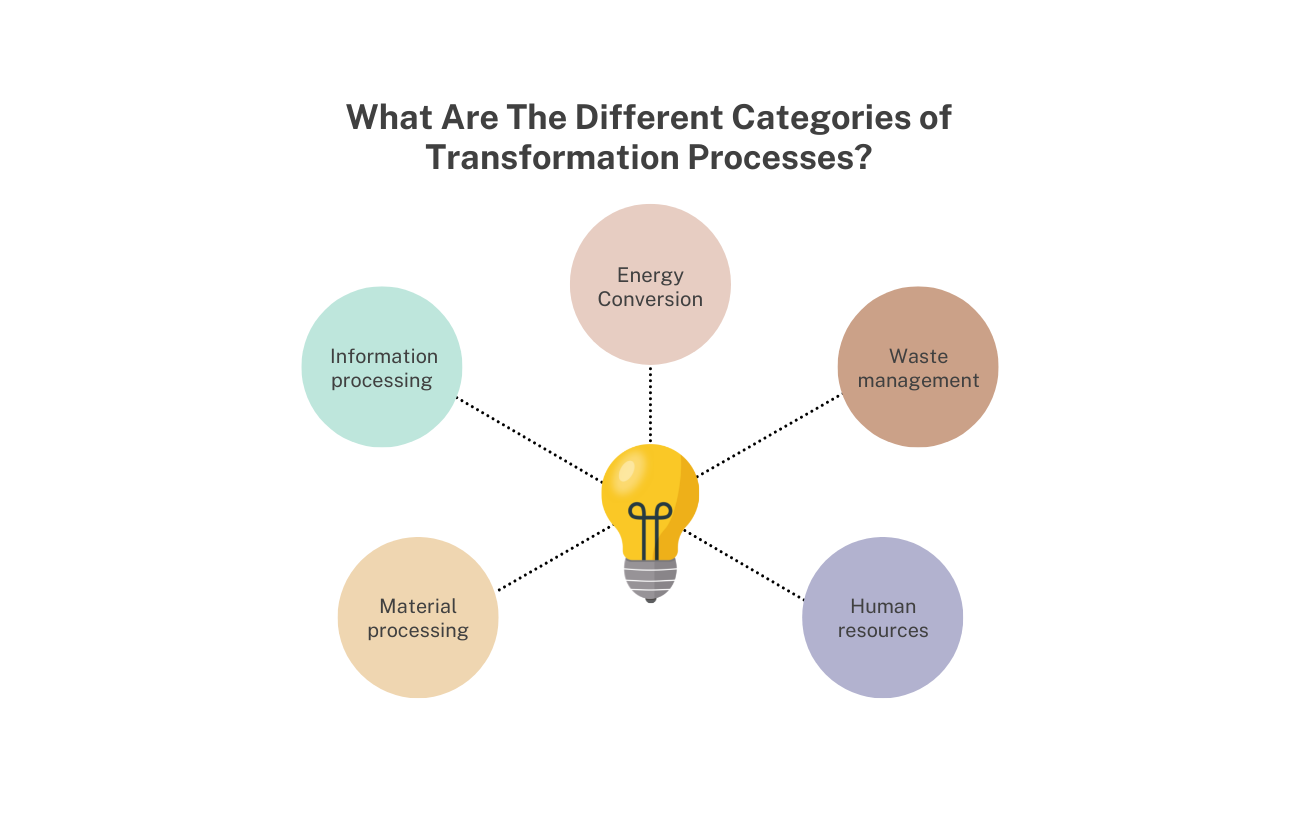
- Material processing: This involves the physical and chemical transformation of raw materials into finished products. Examples include manufacturing industries such as automotive, electronics, and food processing.
- Information processing: This category covers the manipulation of data or information for a specific purpose. It includes activities such as data entry, video editing, and software programming.
- Energy conversion: This is transforming one form of energy into another, such as electricity generation from fossil fuels or solar power.
- Waste management: This encompasses the collection, treatment, and disposal of solid, liquid, and gaseous waste products. It is an integral part of many industrial operations.
- Human resources: The human resources category includes all activities related to recruiting, training, and developing employees. It is pivotal to the success of any organisation that relies on people to achieve its goals.
Conclusion
The transformation process in operations management converts inputs into outputs. This process is essential to the success of any organisation, as it allows for the creation of products and services that customers demand. By understanding the different steps involved in the transformation process, organisations can better optimise their operations and ensure they meet customer needs.
There are plenty of things you need to learn about operations management; we have a course that is just perfect for updating your skills. Check out Advanced Certificate in Operations, Supply Chain and Project Management to get started with your career in operations management or take it up a notch higher.
More Information:
What Is Capacity Planning In Operations Management?
Why Do Businesses Need An Operations Strategy?








